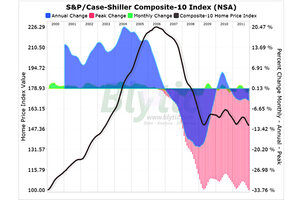Home prices are trending downward
The latest release of the S&P/Case-Shiller (CSI) home price indices for December reported that the Composite-10 price index declined 1.08 percent since November while the Composite-20 index declined 1.11 percent over the same period.

This chart shows the S7P/Case Shiller composite of home price indices since 2000. On average, prices haven't recovered since the downward plunge of 2007-2009.
SoldAtTheTop
Note... be sure to bookmark the overall S&P/Case-Shiller Dashboard or the Scary Housing Dashboard of the weakest markets for a real-time view of all the markets tracked by S&P.
The latest release of the S&P/Case-Shiller (CSI) home price indices for December reported that the non-seasonally adjusted Composite-10 price index declined 1.08% since November while the Composite-20 index declined 1.11% over the same period resulting in the lowest level seen to on the Composite-10 since June 2003 and the largest peak decline seen since the nearly six year old housing bust began in 2006.
The latest CSI data clearly indicates that the price trends are experiencing a declining trend into the typically less active summer and fall season and as I recently pointed out, the more timely and less distorted Radar Logic RPX data is continuing to capture notable falling prices driven primarily by seasonality.
The 10-city composite index declined 3.94% as compared to December 2010 while the 20-city composite declined 3.99% over the same period.
Topping the list of regional peak decliners was Las Vegas at -61.36%, Phoenix at -55.19%, Miami at -50.97%, Tampa at -47.47% and Detroit at -46.17%.
Additionally, both of the broad composite indices show significant peak declines slumping -33.76% for the 10-city national index and -33.80% for the 20-city national index on a peak comparison basis.

